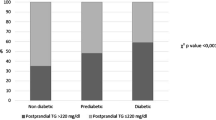Summary
To study the effect of treatment on plasma lipid and lipoprotein concentration and on postheparin-lipolytic activity (PHLA) in plasma, 26 noninsulin-dependent diabetics were investigated who were treated with maximally effective doses of glibenclamide. The patients were randomly divided into two groups: In group I, glibenclamide was replaced by a long-acting insulin preparation given once daily at variable doses until satisfactory metabolic control was achieved. In group II, glibenclamide was replaced by placebo. At weeks 0, 1, 3, 7, and 12 after change of treatment, the following parameters were determined: Blood glucose, plasma concentrations of cholesterol, triglycerides, phospholipids, HDL cholesterol, very-low-density lipoproteins, intermediate-density lipoporteins, low density lipoproteins, high-density lipoproteins2 (HDL2), HDL3, and PHLA. At week 0, no statistically significant differences existed between group I and group II with respect to all parameters mentioned above. The replacement of glibenclamide by insulin resulted in a continous decrease of blood glucose (p<0.01) with a concomitant increase in HDL2 (p<0.01) and in PHLA (p<0.01) during the period of investigation. In contrast, replacement of glibenclamide by placebo exerted no significant influence on all determined parameters during 12 weeks. These data suggest that in noninsulin-dependent diabetics, who are inadequately controlled by sulfonylureas, an adequate insulin substitution is necessary to correct, apart from glucose metabolism, the impaired lipoprotein metabolism of diabetes mellitus. Sulfonylureas per se seem not to decrease the HDL2 fraction nor the PHLA.
Zusammenfassung
Die Wirkung der Behandlungsart des Diabetes auf die Lipide und Lipoproteine und auf die post-heparin-lipolytische Aktivität (PHLA) im Plasma von 26 insulinunabhängigen Diabetikern wurde untersucht. Die Patienten waren bisher mit einer maximal effektiven Dosis von Glibenclamid behandelt worden. Sie wurden in 2 randomisierte Gruppen unterteilt: In Gruppe I wurde Glibenclamid durch ein Insulindepotpräparat ersetzt. Insulin wurde einmal täglich verabreicht und die Dosis solange gesteigert, bis eine zufriedenstellende Einstellung erreicht war. In Gruppe II wurde Glibenclamid durch Placebo ersetzt. Zum Zeitpunkt der Wochen 0, 1, 3, 7 und 12 nach Umstellung der Therapie wurden folgende Parameter bestimmt: Blutglukose, die Plasmakonzentrationen von Cholesterin, Triglyzeriden, Phospholipiden, HDL-cholesterin, very-low-density-lipoproteins, intermediate-density-lipoproteins, low-density-lipoproteins, high-density-lipoproteins2 (HDL2), HDL3 und die PHLA. Zu Beginn der Studie bestanden keine signifikanten Unterschiede zwischen Gruppe I und II im Hinblick auf alle oben angeführten Parameter. Die Umstellung von Glibenclamid auf Insulin resultierte in einem ständigen Abfall der Blutglukose (p<0,01) bei gleichzeitigem Anstieg der HDL2 (p<0,01) und der PHLA (p<0,01) während des Untersuchungszeitraums. Im Gegensatz dazu hatte die Umstellung von Glibenclamid auf Placebo keinen signifikanten Effekt. Die Ergebnisse zeigen, daß bei insulinunabhängigen Diabetikern, die mit Sulphonylharnstoffpräparaten nicht mehr befriedigend eingestellt waren, eine Umstellung auf Insulin nicht nur zu einer weitgehenden Normalisierung des Glukosestoffwechsels sondern auch zu einer signifikanten Besserung der Störung im Lipoproteinstoffwechsel bei Diabetes mellitus führt. Glibenclamid per se dürfte weder die Konzentration der HDL2-fraktion noch die PHLA beeinflussen.
Similar content being viewed by others
References
Bartlett GR (1959) Phosphorus assay in column chromatography. J Biol Chem 234:466–468
Borensztain J, Samols DR, Rubinstein AH (1972) Effects of insulin on lipoprotein lipase activity in the rat heart and adipose tissue. Am J Physiol 223:1271–1275
Burstein M, Scholnick HR, Morfin R (1970) Rapid method for the isolation of lipoproteins from human serum by precipitation with polyanions. J Lip Res 11:583–595
Castelli WP, Doyle JT, Gordon T, Hames CG, Hjortland MC, Hulley SB, Kagan A, Zukel WJ (1977) HDL cholesterol and other lipids in coronary heart disease. The cooperative lipoprotein phenotyping study. Circulation 55:767–772
Corey JE, Zilversmit DB (1977) Validation of a stable emulsion for the assay of lipoprotein lipase activity. J Lab Clin Med 89:666–674
Documenta Geigy (1968) Wissenschaftliche Tabellen, 7. Aufl. Ciba Geigy SA, Basel
Garfinkel AS, Nilsson-Ehle P, Schotz MC (1976) Regulation of lipoprotein lipase induction by insulin. Biochim Biophys Acta 424:264–273
Gofman JW, Young W, Tandy R (1966) Ischaemic heart disease, atherosclerosis, longevity. Circulation 34:679–697
Kessler G, Lederer H (1966) In: Skeggs LT (ed) Automation in analytical chemistry. Technicon Symposion, pp 341–344
Lisch H-J, Sailer S (1981) Lipoprotein patterns in diet, sulphonylurea, and insulin treated diabetics. Diabetologia 20:118–122
Miller GJ, Miller NE (1975) Plasma-high-density-lipoprotein concentration and development of ischaemic heart-disease. Lancet I:16–19
National Diabetes Data Group (1979) Classification and diagnosis of diabetes mellitus and other categories of glucose intolerance. Diabetes 28:1039–1057
Nikkilä EA, Huttunen JK, Ehnholm C (1977) Postheparin plasma lipoprotein lipase and hepatic lipase in diabetes mellitus. Diabetes 26:11–21
Patsch JR, Gotto AM, Olivecrona T, Eisenberg S (1978) Formation of high density lipoprotein2-like particles during lipolysis of very low density lipoproteins in vitro. Proc Natl Acad Sci USA 75:4519–4523
Patsch JR, Sailer S, Kostner G, Sandhofer F, Holasek A, Braunsteiner H (1974) Separation of the main lipoprotein density classes from human plasma by rate zonal ultracentrifugation. J Lip Res 15:356–366
Röschlau P, Bernt E, Gruber W (1974) Enzymatische Bestimmung des Gesamtcholesterins im Serum. J Clin Chem Clin Biochem 12:403–407
Shen S-W, Bressler R (1977) Clinical pharmacology of oral antidiabetic agents. N Engl J Med 296:787–793
Sheperd RE, Fain JN (1977) Inhibition of rat fat cell triglyceride lipase by sulphonylureas. Fed Proc 36:2732–2734
Taskinen M-R, Nikkilä EA (1979) Lipoprotein lipase activity of adipose tissue and skeletal muscle in insulin-deficient human diabetes. Diabetologia 17:351–356
Author information
Authors and Affiliations
Rights and permissions
About this article
Cite this article
Breier, C., Lisch, H.J. & Sailer, S. Effect of treatment on the concentration of lipoproteins and the postheparin-lipolytic activity in the plasma of noninsulin-dependent diabetics. Klin Wochenschr 60, 551–554 (1982). https://doi.org/10.1007/BF01724210
Received:
Accepted:
Issue Date:
DOI: https://doi.org/10.1007/BF01724210
Key words
- Noninsulin-dependent diabetics
- Insulin treatment
- Sulfonylurea treatment
- High-density lipoproteins2
- Postheparin-lipolytic activity




